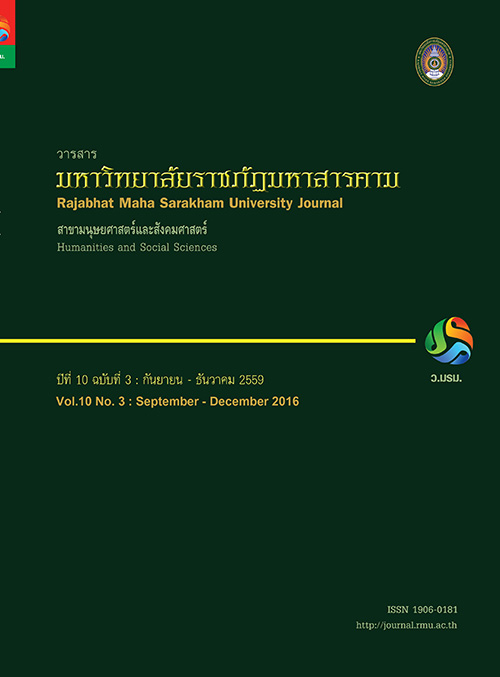การเรียนรู้แบบควอนตัมออนไลน์ ; สไตล์การเรียนรู้ ; การคิดวิเคราะห์;A Learning Model of Online Quantum Learning Base on Learning Styles to Enhance Critical Thinking Abilities for Higher Education Student
Main Article Content
บทคัดย่อ
การวิจัยครั้งนี้มีวัตถุประสงค์ 1) เพื่อสังเคราะห์รูปแบบการเรียนรู้แบบควอนตัมออนไลน์ตามสไตล์การเรียนรู้ที่ส่งเสริมความ
สามารถในการคิดวิเคราะห์สำหรับนักศึกษาระดับปริญญาตรี 2) เพื่อประเมินรูปแบบการเรียนรู้ที่สังเคราะห์ขึ้น วิธีการดำเนินการวิจัย
แบ่งเป็น 2 ขั้นตอน ได้แก่ 1) การสังเคราะห์รูปแบบการเรียนรู้โดยการสัมภาษณ์เชิงลึก กลุ่มตัวอย่างเป็นผู้เชี่ยวชาญในด้านการพัฒนา
รูปแบบ คัดเลือกกลุ่มตัวอย่างแบบเฉพาะเจาะจงได้กลุ่มตัวอย่าง จำนวน 12 คน และ3) การประเมินรูปแบบการเรียนรู้ กลุ่มตัวอย่าง
เป็นผู้ทรงคุณวุฒิด้านการประเมินรูปแบบการเรียนรู้ คัดเลือกกลุ่มตัวอย่างแบบเฉพาะเจาะจงได้กลุ่มตัวอย่าง จำนวน 5 คน เก็บข้อมูล
โดยใช้แบบสอบถามเพื่อประเมินความเหมาะสมของรูปแบบการเรียนรู้ วิเคราะห์ข้อมูลโดยหาค่าเฉลี่ยและส่วนเบี่ยงเบนมาตรฐาน
ผลการวิจัยพบว่า
รูปแบบการเรียนรู้ที่สังเคราะห์ขึ้นมี 4 องค์ประกอบ คือ (1) ด้านส่วนต่อประสานกับผู้ใช้ (2) ด้านจำแนกกลุ่มสไตล์ผู้เรียน (3)
ด้านบริหารจัดการผู้เรียน (4) ด้านการคิดแบบควอนตัม โดยมีกระบวนการเรียนรู้ 4 ขั้นตอน คือ (1) ขั้นเตรียมการคิด(2) ขั้นพิชิต
คำถาม (3) ขั้นติดตามตรวจสอบ และ (4) ขั้นทดสอบประเมินผล และการประเมินรูปแบบการเรียนรู้จากผู้ทรงคุณวุฒิ โดยแบ่งเป็น
4 ด้าน พบว่า (1) ด้านแนวคิดและทฤษฎีในการพัฒนารูปแบบการเรียนรู้ มีความเหมาะสมในระดับมาก (2) ด้านองค์ประกอบของรูป
แบบการเรียนรู้ มีความเหมาะสมในระดับมาก (3) ด้านขั้นตอนการจัดการเรียนรู้ มีความเหมาะสมในระดับมาก และ (4) ด้านการนำรูป
แบบการเรียนรู้ไปใช้งาน มีความเหมาะสมในระดับมาก จึงสรุปได้ว่า รูปแบบการเรียนรู้ที่สังเคราะห์ขึ้น มีผลการประเมินอยู่ในระดับมาก สามารถนำไปเป็นต้นแบบในพัฒนาเครื่องมือในการจัดการเรียนรู้ได้
This research aimed to; firstly, synthesize a learning model based on online quantum learning with
learning styles to enhance critical thinking abilities for higher education students. Lastly, assess the synthesized
model. Model methodology was designed into two steps as follows; 1) step of synthesizing the model using
depth interview, there were selected purposively twelve experts used as samples. And 2) step of assessing
synthesized model by using five of selected purposively learning model experts and also used assessment
form to assess the synthesized model. Data analyzed using arithmetic mean and standard deviation.
Research foundthere were 4 components of synthesized learning model. 1) User interface module 2)
Classifications student module 3) Student management module 4) Quantum thinking module by using 4 steps
learning: (1) Preparation process (2) Question process (3) Verification process and (4) Assessment process.
The learning assessmentof expertise was separated into 4 parts that ; (1) Theory and design modelfor
developing for learning was in high rating scale (2)The components of learning model also was in high rating
scale (3) The step of learning was in high rating scale and (4) The experiment was in high rating scale In
conclusion, the synthesized model is accepted to be developed as a learning tool.
Article Details
1. บทความที่ลงตีพิมพ์ทุกเรื่องได้รับการตรวจทางวิชาการโดยผู้ประเมินอิสระ ผู้ทรงคุณวุฒิ (Peer Review) สาขาที่เกี่ยวข้อง อย่างน้อย 3 ท่าน ในรูปแบบ Double blind review
2. ข้อคิดเห็นใด ๆ ของบทความที่ลงตีพิมพ์ในวารสารมหาวิทยาลัยราชภัฏมหาสารคาม นี้เป็นของผู้เขียน คณะผู้จัดทำวารสารไม่จำเป็นต้องเห็นด้วย
3. กองบรรณาธิการวารสารมหาวิทยาลัยราชภัฏมหาสารคาม ไม่สงวนสิทธิ์การคัดลอกแต่ให้อ้างอิงแสดงที่มา


